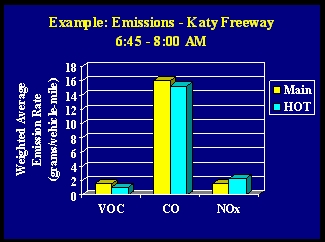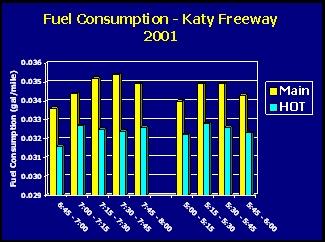Environmental Quality and Health of Pricing and Managed Facilities
Environmental Quality and Public Health
By enabling higher travel speeds and reducing idling caused by congested conditions, managed lanes can reduce fuel consumption. If rideshare and transit services and facilities develop in conjunction or as a result of management strategies, there is potential for even further reductions in fuel consumption. These strategies should consider the energy necessary to power automated systems for signage, toll collection, access control, and speed management. Lower emissions rates and fuel consumption are shown by the comparison between mainline and HOT lanes in the Houston area in Figures 8 and 9. By reducing travel delay along major thoroughfares, managed lane strategies also reduce emission levels of volatile organic compounds (VOC)s and carbon monoxide. This in turn improves air quality, with positive impacts on public and environmental health as well as stormwater quality. Managed lane strategy elements also reduce the likelihood and severity of crashes, in turn reducing the likelihood of injury and fatalities.
|
What do you think the most important environmental and public health effects of managed lanes will be? |
Figure 8 - Emissions

Figure 9- Fuel Consumption

Source: Burris, Mark W. (January, 2003). "Cost Benefit Analysis of the Houston QuickRide Program".
Proceedings from 82nd Annual Meeting of the Transportation Research Board, Washington D.C. College Station, Texas: Texas Transportation Institute, Texas A&M University